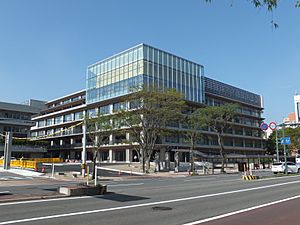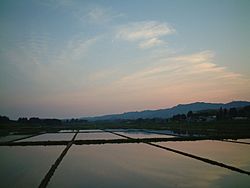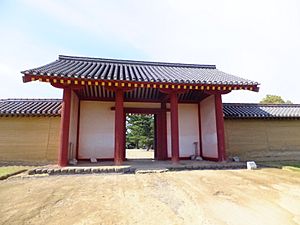Akita (city) facts for kids
Quick facts for kids
Akita
秋田市
|
|||||||||||
|---|---|---|---|---|---|---|---|---|---|---|---|
| Akita City | |||||||||||
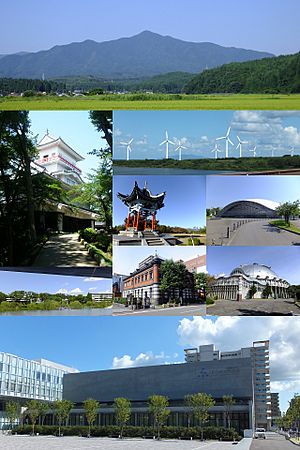
From the top, left to right: Mount Taihei, Kubota Castle, Akita-Araya Wind Farm, Hitotsumori Park, Akita Skydome, Akita Museum of Art, Akita Akarengakan Museum, Akita City Gymnasium
|
|||||||||||
|
|||||||||||
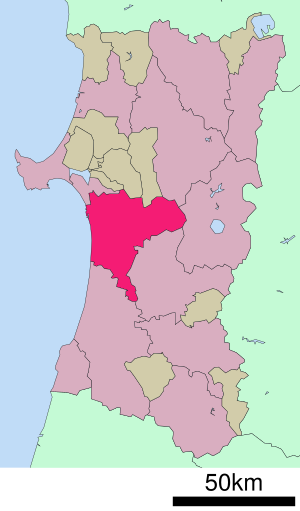 |
|||||||||||
| Country | Japan | ||||||||||
| Region | Tōhoku | ||||||||||
| Prefecture | Akita | ||||||||||
| First official recorded | 659 AD | ||||||||||
| City Settled | April 1, 1889 | ||||||||||
| Area | |||||||||||
| • Total | 906.07 km2 (349.84 sq mi) | ||||||||||
| Population
(August 1, 2023)
|
|||||||||||
| • Total | 300,502 | ||||||||||
| • Density | 331.6543/km2 (858.981/sq mi) | ||||||||||
| Time zone | UTC+9 (Japan Standard Time) | ||||||||||
| Phone number | 018-863-2222 | ||||||||||
| Address | 1-1 Sanno 1-chome, Akita-shi 010-8560 | ||||||||||
| Climate | Cfa | ||||||||||
|
|||||||||||
Akita (秋田市, Akita-shi) IPA: [aꜜki̥ta]; lit. "Autumn field City" is a major city in Japan. It is the capital city of Akita Prefecture. Since 1997, Akita has been known as a "core city." This means it has more self-governing powers.
As of August 2023, about 300,502 people live in Akita. The city covers an area of 906.07 square kilometers (350 square miles).
Contents
History of Akita City
The area where Akita City is today has been lived in for thousands of years. It was once part of an old province called Dewa. Important old sites, like the Jizōden ruins, show that people lived here from the Stone Age.
In 733 AD, the Japanese imperial court built Akita Castle. This was done to control the local tribes. Later, different samurai families ruled the area. During the Edo period, the Satake clan took control. They built Kubota Castle, and a castle town grew around it.
Changes in the Meiji and Taishō Eras
When the Meiji period began, the old ruling system changed. The castle town was split into Akita and Kubota. In 1871, Akita Prefecture was created.
A big fire in 1886 destroyed most of Akita town. But the city was officially formed on April 1, 1889. This included the old towns of Kubota and Akita. Over the next few years, many new things came to Akita. These included a public library, electricity, and telephone services. Akita Station opened in 1902.
During the Taishō period (1912-1926), Akita continued to grow. Oil fields were developed nearby, and a branch of the Bank of Japan opened.
Akita in the Shōwa Era
More oil fields were developed in the 1930s. However, the city faced hardship during World War II. On August 14, 1945, an air raid targeted an oil refinery. Sadly, over 250 people lost their lives.
After the war, Akita hosted the National Sports Festival of Japan in 1961. In 1983, a tsunami hit the coast after an earthquake. Three people in Akita were killed.
Modern Akita: Heisei Era
On April 1, 1997, Akita became a "core city." This gave it more power to manage its own affairs. The Akita Shinkansen (bullet train) also started running that year. In 2001, Akita hosted the World Games, a big international sports event.
In 2005, two nearby towns, Kawabe and Yūwa, joined Akita City. This made Akita even larger. The city also hosted the National Sports Festival again in 2007.
Geography and Climate
Akita City is located on the coast of central Akita Prefecture. It is next to the Sea of Japan to the west. The Omono River flows right through the city.
Neighboring Towns and Cities
Akita City is surrounded by several other places in Akita Prefecture:
- Kitaakita
- Katagami
- Yurihonjō
- Daisen
- Senboku
- Minamiakita District: Gojōme, Ikawa
- Kitaakita District: Kamikoani
Population Changes
Akita's population has been counted since 1873. The number of people living in Akita grew steadily and reached its highest point around the year 2000. Since then, the population has slowly decreased.
| Historical population | ||
|---|---|---|
| Year | Pop. | ±% |
| 1873 | 38,118 | — |
| 1950 | 200,525 | +426.1% |
| 1960 | 229,933 | +14.7% |
| 1970 | 257,532 | +12.0% |
| 1980 | 304,823 | +18.4% |
| 1990 | 322,698 | +5.9% |
| 2000 | 336,646 | +4.3% |
| 2010 | 323,363 | −3.9% |
| 2020 | 305,625 | −5.5% |
Weather in Akita
Akita has a climate that is a mix of humid subtropical and humid continental. This means it has cold, very snowy winters. Summers are hot and humid.
The average temperature in January is about 0.4°C (32.7°F). In August, it rises to about 25.0°C (77.0°F). Akita gets a lot of snow because it's near the Sea of Japan. It receives about 377 cm (148 inches) of snow each winter. Most of the snow falls from December to March. It rains or snows on more than two-thirds of the days each year.
| Climate data for Akita (1991−2020 normals, extremes 1882−present) | |||||||||||||
|---|---|---|---|---|---|---|---|---|---|---|---|---|---|
| Month | Jan | Feb | Mar | Apr | May | Jun | Jul | Aug | Sep | Oct | Nov | Dec | Year |
| Record high °C (°F) | 13.7 (56.7) |
20.1 (68.2) |
21.0 (69.8) |
28.2 (82.8) |
31.8 (89.2) |
33.8 (92.8) |
37.9 (100.2) |
38.5 (101.3) |
36.1 (97.0) |
30.1 (86.2) |
25.2 (77.4) |
21.4 (70.5) |
38.5 (101.3) |
| Mean daily maximum °C (°F) | 3.1 (37.6) |
4.0 (39.2) |
7.9 (46.2) |
14.0 (57.2) |
19.6 (67.3) |
23.7 (74.7) |
27.1 (80.8) |
29.2 (84.6) |
25.4 (77.7) |
19.0 (66.2) |
12.2 (54.0) |
5.9 (42.6) |
15.9 (60.6) |
| Daily mean °C (°F) | 0.4 (32.7) |
0.8 (33.4) |
4.0 (39.2) |
9.6 (49.3) |
15.2 (59.4) |
19.6 (67.3) |
23.4 (74.1) |
25.0 (77.0) |
21.0 (69.8) |
14.5 (58.1) |
8.3 (46.9) |
2.8 (37.0) |
12.1 (53.8) |
| Mean daily minimum °C (°F) | −2.1 (28.2) |
−2.1 (28.2) |
0.4 (32.7) |
5.2 (41.4) |
11.1 (52.0) |
16.0 (60.8) |
20.4 (68.7) |
21.6 (70.9) |
17.1 (62.8) |
10.4 (50.7) |
4.5 (40.1) |
0.0 (32.0) |
8.5 (47.3) |
| Record low °C (°F) | −19.8 (−3.6) |
−24.6 (−12.3) |
−19.5 (−3.1) |
−7.2 (19.0) |
−1.4 (29.5) |
4.1 (39.4) |
8.9 (48.0) |
9.0 (48.2) |
3.1 (37.6) |
−1.4 (29.5) |
−5.4 (22.3) |
−18.7 (−1.7) |
−24.6 (−12.3) |
| Average precipitation mm (inches) | 118.9 (4.68) |
98.5 (3.88) |
99.5 (3.92) |
109.9 (4.33) |
125.0 (4.92) |
122.9 (4.84) |
197.0 (7.76) |
184.6 (7.27) |
161.0 (6.34) |
175.5 (6.91) |
189.1 (7.44) |
159.8 (6.29) |
1,741.6 (68.57) |
| Average snowfall cm (inches) | 100 (39) |
79 (31) |
30 (12) |
1 (0.4) |
0 (0) |
0 (0) |
0 (0) |
0 (0) |
0 (0) |
0 (0) |
6 (2.4) |
58 (23) |
273 (107) |
| Average precipitation days (≥ 0.5 mm) | 23.8 | 20.0 | 17.4 | 13.2 | 12.7 | 11.4 | 13.2 | 11.7 | 13.5 | 16.0 | 19.6 | 23.6 | 196.0 |
| Average relative humidity (%) | 74 | 72 | 68 | 67 | 71 | 74 | 79 | 76 | 74 | 73 | 73 | 74 | 73 |
| Mean monthly sunshine hours | 39.0 | 64.3 | 121.5 | 168.6 | 184.9 | 179.5 | 150.3 | 186.9 | 160.8 | 143.1 | 83.2 | 45.3 | 1,527.4 |
| Source: Japan Meteorological Agency | |||||||||||||
| Climate data for Yūwa, Akita (2003−2020 normals, extremes 2003−present) | |||||||||||||
|---|---|---|---|---|---|---|---|---|---|---|---|---|---|
| Month | Jan | Feb | Mar | Apr | May | Jun | Jul | Aug | Sep | Oct | Nov | Dec | Year |
| Record high °C (°F) | 9.8 (49.6) |
17.0 (62.6) |
20.3 (68.5) |
29.1 (84.4) |
31.4 (88.5) |
33.3 (91.9) |
35.3 (95.5) |
37.2 (99.0) |
34.8 (94.6) |
28.8 (83.8) |
24.3 (75.7) |
14.9 (58.8) |
37.2 (99.0) |
| Mean daily maximum °C (°F) | 1.7 (35.1) |
2.9 (37.2) |
7.1 (44.8) |
13.4 (56.1) |
19.8 (67.6) |
23.8 (74.8) |
26.8 (80.2) |
28.7 (83.7) |
24.8 (76.6) |
18.2 (64.8) |
11.4 (52.5) |
4.4 (39.9) |
15.3 (59.4) |
| Daily mean °C (°F) | −0.9 (30.4) |
−0.5 (31.1) |
2.9 (37.2) |
8.4 (47.1) |
14.6 (58.3) |
18.9 (66.0) |
22.5 (72.5) |
24.1 (75.4) |
19.8 (67.6) |
13.2 (55.8) |
7.1 (44.8) |
1.5 (34.7) |
11.0 (51.7) |
| Mean daily minimum °C (°F) | −3.6 (25.5) |
−3.8 (25.2) |
−1.0 (30.2) |
3.4 (38.1) |
9.7 (49.5) |
14.7 (58.5) |
19.2 (66.6) |
20.3 (68.5) |
15.8 (60.4) |
8.9 (48.0) |
3.3 (37.9) |
−1.2 (29.8) |
7.1 (44.8) |
| Record low °C (°F) | −13.0 (8.6) |
−12.9 (8.8) |
−9.2 (15.4) |
−4.2 (24.4) |
1.1 (34.0) |
6.1 (43.0) |
13.0 (55.4) |
12.2 (54.0) |
6.1 (43.0) |
0.8 (33.4) |
−4.3 (24.3) |
−9.6 (14.7) |
−13.0 (8.6) |
| Average precipitation mm (inches) | 120.1 (4.73) |
97.0 (3.82) |
105.9 (4.17) |
118.6 (4.67) |
117.0 (4.61) |
133.0 (5.24) |
225.7 (8.89) |
207.2 (8.16) |
176.3 (6.94) |
184.8 (7.28) |
205.7 (8.10) |
170.7 (6.72) |
1,862 (73.31) |
| Average snowfall cm (inches) | 77 (30) |
75 (30) |
7 (2.8) |
3 (1.2) |
0 (0) |
0 (0) |
0 (0) |
0 (0) |
0 (0) |
0 (0) |
4 (1.6) |
65 (26) |
230 (91) |
| Average precipitation days (≥ 1.0 mm) | 21.4 | 16.7 | 15.4 | 12.9 | 11.2 | 9.7 | 12.9 | 10.8 | 13.7 | 14.4 | 18.6 | 23.3 | 181 |
| Average snowy days (≥ 1 cm) | 9.5 | 8.0 | 1.0 | 0.5 | 0 | 0 | 0 | 0 | 0 | 0 | 0.5 | 6.0 | 25.5 |
| Source: JMA | |||||||||||||
| Climate data for Iwamisannai, Akita (1991−2020 normals, extremes 1976−present) | |||||||||||||
|---|---|---|---|---|---|---|---|---|---|---|---|---|---|
| Month | Jan | Feb | Mar | Apr | May | Jun | Jul | Aug | Sep | Oct | Nov | Dec | Year |
| Record high °C (°F) | 11.2 (52.2) |
16.1 (61.0) |
19.9 (67.8) |
29.0 (84.2) |
32.5 (90.5) |
33.4 (92.1) |
37.7 (99.9) |
37.3 (99.1) |
34.8 (94.6) |
29.8 (85.6) |
24.8 (76.6) |
18.6 (65.5) |
37.7 (99.9) |
| Mean daily maximum °C (°F) | 1.9 (35.4) |
2.9 (37.2) |
6.9 (44.4) |
13.9 (57.0) |
19.9 (67.8) |
24.0 (75.2) |
27.0 (80.6) |
28.8 (83.8) |
24.9 (76.8) |
18.4 (65.1) |
11.2 (52.2) |
4.5 (40.1) |
15.4 (59.6) |
| Daily mean °C (°F) | −1.3 (29.7) |
−0.9 (30.4) |
2.2 (36.0) |
8.2 (46.8) |
14.2 (57.6) |
18.7 (65.7) |
22.5 (72.5) |
23.7 (74.7) |
19.4 (66.9) |
12.6 (54.7) |
6.4 (43.5) |
1.1 (34.0) |
10.6 (51.0) |
| Mean daily minimum °C (°F) | −4.5 (23.9) |
−4.5 (23.9) |
−2.2 (28.0) |
2.4 (36.3) |
8.6 (47.5) |
13.8 (56.8) |
18.6 (65.5) |
19.4 (66.9) |
14.6 (58.3) |
7.5 (45.5) |
2.0 (35.6) |
−2.0 (28.4) |
6.1 (43.1) |
| Record low °C (°F) | −16.4 (2.5) |
−14.6 (5.7) |
−12.9 (8.8) |
−8.2 (17.2) |
−1.2 (29.8) |
3.2 (37.8) |
9.6 (49.3) |
9.7 (49.5) |
3.4 (38.1) |
−1.6 (29.1) |
−5.8 (21.6) |
−12.9 (8.8) |
−16.4 (2.5) |
| Average precipitation mm (inches) | 141.8 (5.58) |
120.3 (4.74) |
119.7 (4.71) |
129.1 (5.08) |
149.2 (5.87) |
156.8 (6.17) |
258.1 (10.16) |
230.4 (9.07) |
184.1 (7.25) |
189.6 (7.46) |
198.5 (7.81) |
175.6 (6.91) |
2,052.9 (80.82) |
| Average precipitation days (≥ 1.0 mm) | 21.8 | 19.0 | 16.8 | 13.4 | 12.7 | 11.7 | 14.3 | 12.1 | 13.6 | 15.4 | 18.5 | 22.1 | 191.4 |
| Mean monthly sunshine hours | 40.9 | 61.6 | 100.3 | 147.8 | 178.3 | 174.3 | 143.0 | 177.5 | 149.3 | 130.4 | 85.5 | 45.6 | 1,431.1 |
| Source: Japan Meteorological Agency | |||||||||||||
| Climate data for Daishōji, Akita (1991−2020 normals, extremes 1976−present) | |||||||||||||
|---|---|---|---|---|---|---|---|---|---|---|---|---|---|
| Month | Jan | Feb | Mar | Apr | May | Jun | Jul | Aug | Sep | Oct | Nov | Dec | Year |
| Record high °C (°F) | 11.9 (53.4) |
14.8 (58.6) |
20.8 (69.4) |
28.8 (83.8) |
31.8 (89.2) |
32.8 (91.0) |
36.4 (97.5) |
37.2 (99.0) |
34.3 (93.7) |
29.9 (85.8) |
23.5 (74.3) |
17.4 (63.3) |
37.2 (99.0) |
| Mean daily maximum °C (°F) | 2.1 (35.8) |
3.1 (37.6) |
7.1 (44.8) |
14.2 (57.6) |
20.1 (68.2) |
24.1 (75.4) |
27.1 (80.8) |
28.8 (83.8) |
24.7 (76.5) |
18.3 (64.9) |
11.3 (52.3) |
4.5 (40.1) |
15.5 (59.8) |
| Daily mean °C (°F) | −0.9 (30.4) |
−0.6 (30.9) |
2.3 (36.1) |
8.2 (46.8) |
14.1 (57.4) |
18.6 (65.5) |
22.4 (72.3) |
23.6 (74.5) |
19.2 (66.6) |
12.5 (54.5) |
6.3 (43.3) |
1.2 (34.2) |
10.6 (51.0) |
| Mean daily minimum °C (°F) | −3.8 (25.2) |
−3.9 (25.0) |
−1.8 (28.8) |
2.4 (36.3) |
8.5 (47.3) |
13.8 (56.8) |
18.5 (65.3) |
19.3 (66.7) |
14.7 (58.5) |
7.7 (45.9) |
2.0 (35.6) |
−1.7 (28.9) |
6.3 (43.4) |
| Record low °C (°F) | −15.1 (4.8) |
−16.1 (3.0) |
−12.8 (9.0) |
−8.8 (16.2) |
−1.5 (29.3) |
4.6 (40.3) |
8.4 (47.1) |
9.9 (49.8) |
3.5 (38.3) |
−1.4 (29.5) |
−8.1 (17.4) |
−12.4 (9.7) |
−16.1 (3.0) |
| Average precipitation mm (inches) | 169.7 (6.68) |
121.0 (4.76) |
115.4 (4.54) |
117.4 (4.62) |
130.0 (5.12) |
148.1 (5.83) |
229.6 (9.04) |
226.2 (8.91) |
193.9 (7.63) |
198.0 (7.80) |
227.0 (8.94) |
212.9 (8.38) |
2,089 (82.24) |
| Average snowfall cm (inches) | 199 (78) |
160 (63) |
73 (29) |
2 (0.8) |
0 (0) |
0 (0) |
0 (0) |
0 (0) |
0 (0) |
0 (0) |
12 (4.7) |
119 (47) |
564 (222) |
| Average precipitation days (≥ 1.0 mm) | 23.9 | 19.5 | 17.2 | 12.8 | 12.4 | 11.0 | 13.9 | 12.2 | 14.0 | 16.1 | 19.7 | 23.9 | 196.6 |
| Average snowy days (≥ 3 cm) | 21.5 | 18.2 | 10.0 | 0.3 | 0 | 0 | 0 | 0 | 0 | 0 | 1.0 | 12.4 | 63.4 |
| Mean monthly sunshine hours | 32.6 | 53.0 | 106.9 | 167.3 | 188.2 | 177.5 | 150.2 | 185.4 | 150.7 | 132.3 | 80.9 | 39.9 | 1,464.8 |
| Source: Japan Meteorological Agency | |||||||||||||
Akita's Economy
Akita's economy relies a lot on farming, especially growing rice. Forestry (working with trees) and mining are also important. Akita has one of Japan's most important oil fields.
The main industries here include refining oil, woodworking, and making metal products. They also produce silk fabrics. Akita is home to two big local banks: Akita Bank and Hokuto Bank. The Akita Thermal Power Station is also located in the city.
Education in Akita
Akita City has many schools and universities.
Universities and Colleges
- Akita University
- Akita University of Art
- Akita Prefectural University
- Akita International University
- Akita Nutrition Junior College
- Japanese Red Cross Akita College of Nursing
- Misono Gakuen Junior College
- North Asia University
- Open University of Japan Akita learning center
- Seirei Women's Junior College
Schools for Kids
Akita has 44 city elementary schools and one national elementary school. For middle school, there are 22 city schools, one prefectural, one national, and one private middle school. There is also one school that combines middle and high school.
The city has eight prefectural high schools, one city high school, and seven private high schools. There are also special education schools for students with unique needs.
High Schools
- Akita High School
Getting Around Akita
Akita has different ways to travel, including by air, train, and road.
Airport
- Akita Airport
Train Travel
- JR East – Akita Shinkansen (bullet train)
- Akita
![]() East Japan Railway Company - Ōu Main Line
East Japan Railway Company - Ōu Main Line
- Ōbarino - Wada - Yotsugoya - Akita - Tsuchizaki - Kami-Iijima - Oiwake
![]() East Japan Railway Company - Uetsu Main Line
East Japan Railway Company - Uetsu Main Line
- Shimohama - Katsurane - Araya - Ugo-Ushijima - Akita
![]() East Japan Railway Company - Oga Line
East Japan Railway Company - Oga Line
- Oiwake
- Akita Rinkai Railway Company (for cargo trains)
Highways

 Akita Expressway
Akita Expressway Nihonkai-Tōhoku Expressway
Nihonkai-Tōhoku Expressway National Route 7
National Route 7 National Route 13
National Route 13 National Route 46
National Route 46 National Route 101
National Route 101 National Route 285
National Route 285 National Route 341
National Route 341
Bus Services
- Akita Chūō Kōtsū
Seaport
- Port of Akita
News and Media
- Akita Asahi Broadcasting
- Akita Broadcasting System
- Akita Community Broadcasting
- Akita Television
- Cable Networks Akita
- FM Tsubakidai
Fun Places to Visit
- Site of Kubota Castle (now Senshu Park)
- Site of Akita Castle (Takashimizu Park), a National Historic Site
- Minato Castle (Tsuchizaki Gaiku Park, Shinmeisha)
- Jizōden ruins, another National Historic Site
- Akita Prefectural Museum
- Akita Senshū Museum of Art
- Akita Museum of Art
- Akita Omoriyama Zoo
- Akita Port Tower Selion
- CNA Arena Akita (a sports arena)
- Sakigake Yabase Baseball Stadium
- Akita Prefectural Baseball Stadium
- Akita Yabase Athletic Field
- Akita Prefectural Gymnasium
- Akita Prefectural Central Park
- Akita Prefectural General Pool
- Akita Prefectural Budokan
- Akita Peace Pagoda
- Koshiō Shrine
Exciting Local Events
Akita Kanto Festival
This amazing summer festival started about 350 years ago. It's similar to other tanabata festivals in Japan. During this festival, people balance very tall poles (15 meters or 49 feet) with 230 lanterns on their chins! The main event happens at night from August 3rd to 6th each year.
During the day, people can watch or even try Kanto stunts in Senshu Park. This part of the festival began in 1931. The festival has even been shown in other countries, like Germany, Hawaii, and London!
Narayama Kamakura Festival
In the Narayama Otamachi area of Akita, there's a special festival from February 12th to 15th. People build a shrine from snow walls. Inside, they honor Suijin and Kamakura Daimyojin (local gods). A rice bale is set on fire at the end of the festival.
Tsuchizaki Minato Festival
Every neighborhood in Tsuchizaki Minato creates a special parade float. These floats are decorated with giant figures. The festival takes place from July 20th to 21st. In 1997, it was recognized as an important cultural event.
Our Lady of Akita
In 1973, a nun named Sister Agnes Katsuko Sasagawa reported seeing visions in Akita City. These visions are known as Our Lady of Akita. The Catholic Church approved these reported events in 1988.
Sister Cities Around the World
Akita City has special friendly relationships with cities in other countries.
International Sister Cities
 Lanzhou, Gansu, China (since 1982)
Lanzhou, Gansu, China (since 1982) Passau, Lower Bavaria, Germany (since 1984)
Passau, Lower Bavaria, Germany (since 1984) Malabon, Philippines (since 1987)
Malabon, Philippines (since 1987) Kenai, Alaska, United States of America
Kenai, Alaska, United States of America St. Cloud, Minnesota, United States of America (since 1993, originally with Yūwa, which merged with Akita)
St. Cloud, Minnesota, United States of America (since 1993, originally with Yūwa, which merged with Akita) Vladivostok, Primorsky Krai, Russia (since 1992)
Vladivostok, Primorsky Krai, Russia (since 1992) Nanning, Guangxi, China (since 2021)
Nanning, Guangxi, China (since 2021)
Sister Cities in Japan
Akita also has friendly ties with cities within Japan.
 Daigo, Kuji District, Ibaraki Prefecture
Daigo, Kuji District, Ibaraki Prefecture Hitachiōta, Ibaraki Prefecture
Hitachiōta, Ibaraki Prefecture
Famous People from Akita
Many talented people come from Akita, including:
- Masamichi Amano, a composer
- Michio Ashikaga, a professional soccer player
- Yukiko Ebata, a professional women's volleyball player
- Hiroki Endo, a manga artist
- Yukio Endō, an Olympic gymnast
- Hiroyuki Enoki, a professional boxer
- Shirō Fukai, a composer
- Takunosuke Funakawa, a footballer
- Masanori Ishikawa, a professional baseball player
- Yudai Koga (K), a member of the Japanese boy-group &Team
- Chūji Machida, a politician and cabinet minister
- Hiroya Matsumoto, an actor
- Hiroko Nagasaki, an Olympic swimmer
- Emiko Okuyama, a politician
- Akira Ota, an Olympic wrestler
- Junko Sakurada, a singer
- Nozomi Sasaki, a model and actress
- Takenori Sato, a professional mixed martial artist
- Tadashi Settsu, a professional baseball player
- Kohei Shimoda, a professional soccer player
- Taro Shoji, a singer
- Tensho Sugimoto, a basketball player
- Kenji Suzuki (footballer)
- Mitsuhisa Taguchi, a professional soccer player
- Kenta Tateyama, a professional basketball player
- Go Togashi, a footballer for Blaublitz Akita
- Setsurō Wakamatsu, a movie director
- Ren Yamamoto (footballer, born 1999)
- Koharu Yonemoto, a professional badminton player
- Yu Takahashi, a singer-songwriter
Sports Teams in Akita
Akita is home to several sports teams:
- Basketball: Akita Northern Happinets, Prestige International Aranmare Akita
- Football: Blaublitz Akita, Saruta Kōgyō S.C., Akita FC Cambiare
- Rugby union: Akita Northern Bullets
Images for kids
See also
 In Spanish: Akita (Akita) para niños
In Spanish: Akita (Akita) para niños





